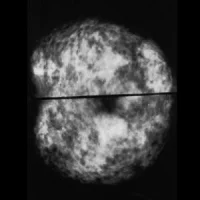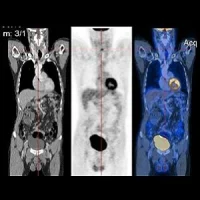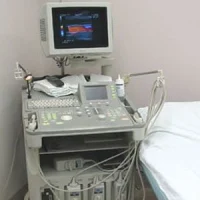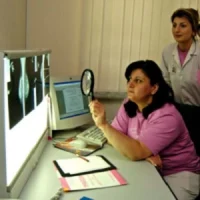A new study has found that women with a history of a false-positive mammogram result may be at increased risk of developing breast cancer for up to 10 years after the false-positive result.
The study, by Louise M. Henderson, PhD, assistant professor of radiology at the University of North Carolina School of Medicine and colleagues is published in Cancer Epidemiology, Biomarkers & Prevention (American Association for Cancer Research). The researchers analysed data from the Breast Cancer Surveillance Consortium (BCSC) from 1994 to 2009. As false positives are more common in the U.S. than in Europe, this was the first study to examine if a false-positive result influences the risk of developing breast
cancer differently for those with nondense versus dense breasts.
The chance of at least one false-positive result is 61 percent for women screened annually and 42 percent for women screened every two years. Around 67 percent of women 40 and over undergo screening mammography in the U.S. False-positive results usually mean women are referred for additional imaging and possibly a breast biopsy.
The cases analysed came from seven registries across the United States, and included 2.2 million screening mammograms performed in 1.3 million women, aged 40 to 74 years. The women were tracked over 10 years.
After adjusting for common factors that influence breast cancer risk, Henderson and colleagues found that women whose mammograms were classified as false-positive and were referred for additional imaging had a 39 percent higher risk of developing subsequent breast cancer during the 10-year follow-up period, compared with women with a true-negative result. Women who had a false-positive result and were referred for a breast biopsy had a 76 percent increased chance of developing subsequent breast cancer compared with women with a true-negative result.
The authors conclude: “This information should be considered for inclusion in risk prediction models to better stratify women into risk categories that may be used to personalise breast cancer screening and primary prevention strategies for individual women.”
Henderson said, "Our finding that breast cancer risk remains elevated up to 10 years after the false-positive result suggests that the radiologist observed suspicious findings on mammograms that are a marker of future cancer risk. Given that the initial result is a false-positive, it is possible that the abnormal pattern, while noncancerous, is a radiographic marker associated with subsequent cancer."
Henderson urged caution regarding the study findings, as the increase in absolute risk with a false-positive mammogram is modest. "We don't want women to read this and feel worried," she said. "We intend for our findings to be a useful tool in the context of other risk factors" such as age, race, and family history of breast cancer.
Source: American Association of Cancer Research
Image source: Wikimedia Commons
The study, by Louise M. Henderson, PhD, assistant professor of radiology at the University of North Carolina School of Medicine and colleagues is published in Cancer Epidemiology, Biomarkers & Prevention (American Association for Cancer Research). The researchers analysed data from the Breast Cancer Surveillance Consortium (BCSC) from 1994 to 2009. As false positives are more common in the U.S. than in Europe, this was the first study to examine if a false-positive result influences the risk of developing breast
cancer differently for those with nondense versus dense breasts.
The chance of at least one false-positive result is 61 percent for women screened annually and 42 percent for women screened every two years. Around 67 percent of women 40 and over undergo screening mammography in the U.S. False-positive results usually mean women are referred for additional imaging and possibly a breast biopsy.
The cases analysed came from seven registries across the United States, and included 2.2 million screening mammograms performed in 1.3 million women, aged 40 to 74 years. The women were tracked over 10 years.
After adjusting for common factors that influence breast cancer risk, Henderson and colleagues found that women whose mammograms were classified as false-positive and were referred for additional imaging had a 39 percent higher risk of developing subsequent breast cancer during the 10-year follow-up period, compared with women with a true-negative result. Women who had a false-positive result and were referred for a breast biopsy had a 76 percent increased chance of developing subsequent breast cancer compared with women with a true-negative result.
The authors conclude: “This information should be considered for inclusion in risk prediction models to better stratify women into risk categories that may be used to personalise breast cancer screening and primary prevention strategies for individual women.”
Henderson said, "Our finding that breast cancer risk remains elevated up to 10 years after the false-positive result suggests that the radiologist observed suspicious findings on mammograms that are a marker of future cancer risk. Given that the initial result is a false-positive, it is possible that the abnormal pattern, while noncancerous, is a radiographic marker associated with subsequent cancer."
Henderson urged caution regarding the study findings, as the increase in absolute risk with a false-positive mammogram is modest. "We don't want women to read this and feel worried," she said. "We intend for our findings to be a useful tool in the context of other risk factors" such as age, race, and family history of breast cancer.
Source: American Association of Cancer Research
Image source: Wikimedia Commons
References:
Henderson LM, Hubbard RA, Sprague BL et al. Increased risk of developing breast cancer after a false-positive screening mammogram. Cancer Epidemiol Biomarkers Prev, 24(12): 1882-9.
Latest Articles
Breast cancer, False positivies, Risk
A new study has found that women with a history of a false-positive mammogram result may be at increased risk of developing breast cancer for up to 10 years after the false-positive result.










